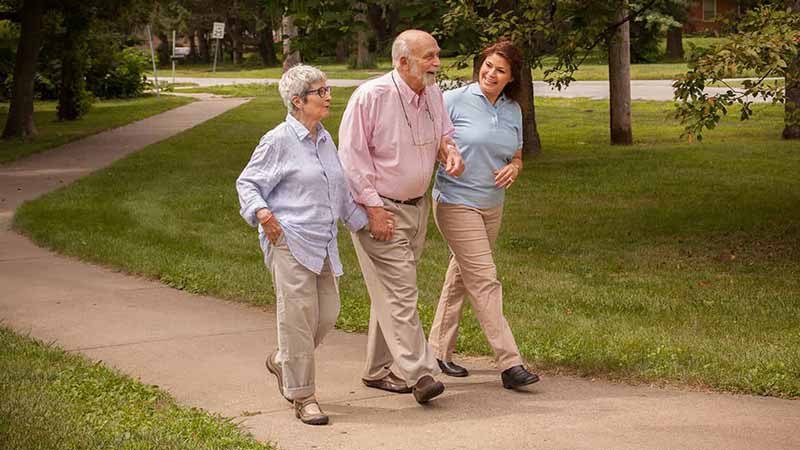

It’s Never Too Late To Start! 4 Tips for Getting Started With Exercise
Are you one of those energetic and motivated folks who always makes time for exercise, or whose lifestyle gives them lots of physical activity? You’re our hero! We all know how important physical fitness is to aging well, but many of us find it challenging for a variety of reasons. People may feel they don’t have time for exercise, don’t know exactly what they should be doing, or they may be afraid of falling or otherwise injuring themselves.
Those and other thoughts stand between us and the many benefits of physical activity. So, how do we overcome the temptations of a sedentary lifestyle, and make the leap to doing things that will help us mentally and physically? Try keeping it slow, simple and fun—and have some “stretch goals” to work toward.
Tip 1: Determine How Much Exercise You Need
First, some basics—and a caution. If you do not currently exercise, these recommendations from the U.S. Department of Health and Human Services (HHS) might discourage you. That’s why experts advise starting slow. Anything is an improvement over nothing! For the best health benefits, the HHS says adults should plan to have:
- At least 150-300 minutes (2½ to 5 hours) each week of moderate-intensity aerobic physical activity;
- OR, 75-150 minutes (1 hour 15 minutes to 2½ hours) each week of vigorous-intensity aerobic physical activity;
- OR, an equivalent combination of the two.
It’s best to spread your aerobic activity throughout the week. And about that “should do” part of the HHS recommendation … think of the above as a target, not something you should be able to do right away. Of course, talk to your doctor before you start any new exercise program.
Tip 2: Start Slow
What’s wonderful about getting more physical activity is that pretty much anything counts. It’s not just the usual activities like walking and jogging that help, but also things you wouldn’t think of as exercise. Housecleaning, yard work or gardening, and preparing a meal all get you on your feet and using different muscle groups. If you’ve done any of those things today, you’ve already got a good start!
When you’re ready to do something that feels more like “exercise,” the easiest way to start is walking. Walk whenever you can, and at a brisk pace whenever possible. But remember: You’re not in a race with anyone. If you walk one block, give yourself a pat on the back!
Stretch goal: A recent study of 78,000 adults ages 40 to 79 showed that walking at least 3,800 steps a day can reduce one’s dementia risk by 25%. That’s about 1.8 miles, give or take, depending on the length of your stride.
Tip 3: Keep It Simple
There’s no need to spend money on new athletic shoes, clothes or equipment to get in shape. Wear your most comfortable shoes. Put on loose-fitting clothing that allows you to move easily. Use simple household items instead of gym equipment. Cans of soup or vegetables work great as weights. Use a belt to stretch your arms over your head.
Stretch goal: Find a senior-oriented exercise class near you. They are typically offered by senior centers, community centers and local gyms, and are often free. These classes generally run about 45 minutes, and participants are encouraged to go at their own pace. You’ll have a chair to use, along with other equipment such as hand weights.
Tip 4: Have Fun!
As with anything else in life, if it’s fun, we keep doing it. The ideal situation is to find activities that work your body while you’re having fun. That’s why so many doctors approve of patients who garden and keep themselves busy around the house. Their exercise fits into their lives seamlessly.
If you’re a social person, join or start a walking group. Need some rejuvenating time to yourself? Find a gentle yoga or yoga for seniors class. Dance in your living room!
Stretch goal: The big fun-fitness craze right now is pickleball. It’s like tennis, but with much smaller courts, pingpong-sized paddles, and light plastic balls. Think about finding a class and checking it out. Pickleball attracts players of all ages and abilities, so it should be easy to find partners who are just your speed.
Did you know that a Right at Home caregiver can help you be more active? We’re happy to help you find ways to exercise, and we’ll be right there with you! Our caregivers can provide safety supervision, encouragement, and even a steady hand. They can also provide daily health reminders, assist with light housekeeping and meal preparation, or help with mobility and grooming/dressing. Find out more by contacting the closest Right at Home office today and asking for a FREE in-home consultation.







